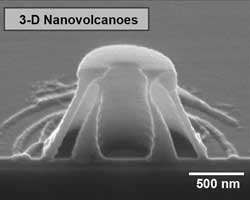
Erupting ‘nanovolcanoes’ for drug delivery
“Nanovolcanoes” carved out of a synthetic polymer using UV light can store and release precise amounts of materials, which its creators say makes it suitable for drug-delivery technologies.
North Carolina State University researchers created the nanovolcanoes by placing transparent, spherical nanoparticles directly on a thin film that, when irradiated with UV light, underwent a chemical change. The film was submerged in a liquid solution that washed away the parts of the film exposed to the light, yielding a small mound with a hollow core.

Cross section of a nanovolcano carved using UV light. The nanovolcanoes have precisely measured hollow cores and openings at their “mouth,” which make them a good candidate for drug-delivery mechanisms, its developers at North Carolina State University say. Courtesy of Chih-Hao Chang, NC State.
“We can control the pattern of light by changing the diameter of the nanoparticle spheres, or by changing the wavelength of the light that we shine through the spheres,” said Xu Zhang, a doctoral student in mechanical and aerospace engineering. “That means we can control the shape and geometry of these structures, such as how big the cavity of the nanovolcano will be.”
By controlling the cavity’s size, the researchers are able to control the size of the drug payload. And, like a volcano, the structures have a hole at the top, the size of which controls the rate of release.
A highly accurate computer model was developed to predict the shape and dimensions of the nanovolcanoes based on the diameter of the nanoscale sphere and the wavelength of light.
“The materials used in this process are relatively inexpensive, and the process can be easily scaled up,” said assistant professor of mechanical and aerospace engineering Dr. Chih-Hao Chang. “In addition, we can produce the nanovolcanoes in a uniformly patterned array, which may also be useful for controlling drug delivery.”
The investigators now are working to improve their understanding of the nanovolcano’s release rate, including how quickly nanoparticles of different sizes will “escape” from different-sized volcano mouths.
“That’s essential information for drug-delivery applications,” Chang said. “It’s exciting to take our understanding of how light scatters by particles and apply it to nanolithography in order to come up with something that could actually help people.”
The research appeared in ACS Nano (doi: 10.1021/nn402637a).
Published: September 2013